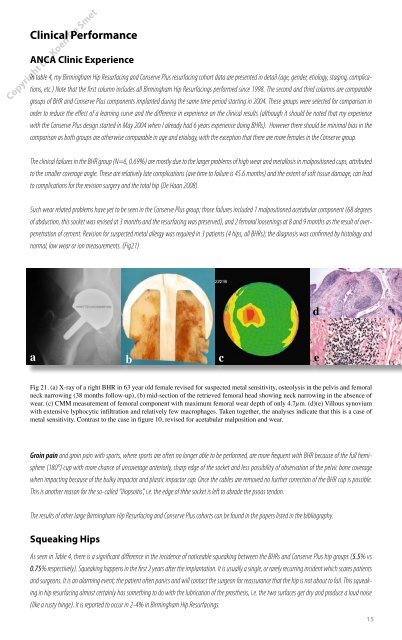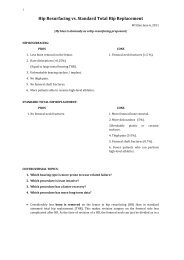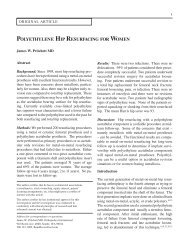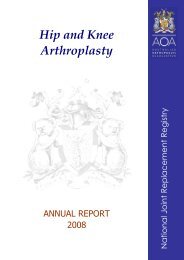Birmingham H ip Resurfacing v ersus C onserv e Plus M etal-on-M ...
Birmingham H ip Resurfacing v ersus C onserv e Plus M etal-on-M ...
Birmingham H ip Resurfacing v ersus C onserv e Plus M etal-on-M ...
You also want an ePaper? Increase the reach of your titles
YUMPU automatically turns print PDFs into web optimized ePapers that Google loves.
Clinical Performance<br />
ANCA Clinic Experience<br />
In table 4, my <str<strong>on</strong>g>Birmingham</str<strong>on</strong>g> H<str<strong>on</strong>g>ip</str<strong>on</strong>g> <str<strong>on</strong>g>Resurfacing</str<strong>on</strong>g> and C<str<strong>on</strong>g><strong>on</strong>serv</str<strong>on</strong>g>e <str<strong>on</strong>g>Plus</str<strong>on</strong>g> resurfacing cohort data are presented in detail (age, gender, etiology, staging, complicati<strong>on</strong>s,<br />
etc.) Note that the first column includes all <str<strong>on</strong>g>Birmingham</str<strong>on</strong>g> H<str<strong>on</strong>g>ip</str<strong>on</strong>g> <str<strong>on</strong>g>Resurfacing</str<strong>on</strong>g>s performed since 1998. The sec<strong>on</strong>d and third columns are comparable<br />
groups of BHR and C<str<strong>on</strong>g><strong>on</strong>serv</str<strong>on</strong>g>e <str<strong>on</strong>g>Plus</str<strong>on</strong>g> comp<strong>on</strong>ents implanted during the same time period starting in 2004. These groups were selected for comparis<strong>on</strong> in<br />
order to reduce the effect of a learning curve and the difference in experience <strong>on</strong> the clinical results (although it should be noted that my experience<br />
with the C<str<strong>on</strong>g><strong>on</strong>serv</str<strong>on</strong>g>e <str<strong>on</strong>g>Plus</str<strong>on</strong>g> design started in May 2004 when I already had 6 years experience doing BHRs). However there should be minimal bias in the<br />
comparis<strong>on</strong> as both groups are otherwise comparable in age and etiology, with the excepti<strong>on</strong> that there are more females in the C<str<strong>on</strong>g><strong>on</strong>serv</str<strong>on</strong>g>e group.<br />
Copyright Dr. Koen De Smet<br />
The clinical failures in the BHR group (N=6, 0.69%) are mostly due to the larger problems of high wear and m<str<strong>on</strong>g>etal</str<strong>on</strong>g>losis in malpositi<strong>on</strong>ed cups, attributed<br />
to the smaller coverage angle. These are relatively late complicati<strong>on</strong>s (ave time to failure is 45.6 m<strong>on</strong>ths) and the extent of soft tissue damage, can lead<br />
to complicati<strong>on</strong>s for the revisi<strong>on</strong> surgery and the total h<str<strong>on</strong>g>ip</str<strong>on</strong>g> (De Haan 2008).<br />
Such wear related problems have yet to be seen in the C<str<strong>on</strong>g><strong>on</strong>serv</str<strong>on</strong>g>e <str<strong>on</strong>g>Plus</str<strong>on</strong>g> group; those failures included 1 malpositi<strong>on</strong>ed acetabular comp<strong>on</strong>ent (68 degrees<br />
of abducti<strong>on</strong>, this socket was revised at 3 m<strong>on</strong>ths and the resurfacing was preserved), and 2 femoral loosenings at 8 and 9 m<strong>on</strong>ths as the result of overpenetrati<strong>on</strong><br />
of cement. Revisi<strong>on</strong> for suspected m<str<strong>on</strong>g>etal</str<strong>on</strong>g> allergy was required in 3 patients (4 h<str<strong>on</strong>g>ip</str<strong>on</strong>g>s, all BHRs); the diagnosis was c<strong>on</strong>firmed by histology and<br />
normal, low wear or i<strong>on</strong> measurements. (Fig21)<br />
a b c<br />
Fig 21. (a) X-ray of a right BHR in 63 year old female revised for suspected m<str<strong>on</strong>g>etal</str<strong>on</strong>g> sensitivity, osteolysis in the pelvis and femoral<br />
neck narrowing (38 m<strong>on</strong>ths follow-up), (b) mid-secti<strong>on</strong> of the retrieved femoral head showing neck narrowing in the absence of<br />
wear. (c) CMM measurement of femoral comp<strong>on</strong>ent with maximum femoral wear depth of <strong>on</strong>ly 4.7µm. (d)(e) Villous synovium<br />
with extensive lyphocytic infiltrati<strong>on</strong> and relatively few macrophages. Taken together, the analyses indicate that this is a case of<br />
m<str<strong>on</strong>g>etal</str<strong>on</strong>g> sensitivity. C<strong>on</strong>trast to the case in figure 10, revised for acetabular malpositi<strong>on</strong> and wear.<br />
Groin pain and groin pain with sports, where sports are often no l<strong>on</strong>ger able to be performed, are more frequent with BHR because of the full hemisphere<br />
(180°) cup with more chance of uncoverage anteriorly, sharp edge of the socket and less possibility of observati<strong>on</strong> of the pelvic b<strong>on</strong>e coverage<br />
when impacting because of the bulky impactor and plastic impactor cap. Once the cables are removed no further correcti<strong>on</strong> of the BHR cup is possible.<br />
This is another reas<strong>on</strong> for the so-called “iliopsoitis”, i.e. the edge of thhe socket is left to abrade the psoas tend<strong>on</strong>.<br />
The results of other large <str<strong>on</strong>g>Birmingham</str<strong>on</strong>g> H<str<strong>on</strong>g>ip</str<strong>on</strong>g> <str<strong>on</strong>g>Resurfacing</str<strong>on</strong>g> and C<str<strong>on</strong>g><strong>on</strong>serv</str<strong>on</strong>g>e <str<strong>on</strong>g>Plus</str<strong>on</strong>g> cohorts can be found in the papers listed in the bibliography.<br />
Squeaking H<str<strong>on</strong>g>ip</str<strong>on</strong>g>s<br />
As seen in Table 4, there is a significant difference in the incidence of noticeable squeaking between the BHRs and C<str<strong>on</strong>g><strong>on</strong>serv</str<strong>on</strong>g>e <str<strong>on</strong>g>Plus</str<strong>on</strong>g> h<str<strong>on</strong>g>ip</str<strong>on</strong>g> groups (5.5% vs<br />
0.75% respectively). Squeaking happens in the first 2 years after the implantati<strong>on</strong>. It is usually a single, or rarely recurring incident which scares patients<br />
and surge<strong>on</strong>s. It is an alarming event; the patient often panics and will c<strong>on</strong>tact the surge<strong>on</strong> for reassurance that the h<str<strong>on</strong>g>ip</str<strong>on</strong>g> is not about to fail. This squeaking<br />
in h<str<strong>on</strong>g>ip</str<strong>on</strong>g> resurfacing almost certainly has something to do with the lubricati<strong>on</strong> of the prosthesis, i.e. the two surfaces get dry and produce a loud noise<br />
(like a rusty hinge). It is reported to occur in 2-4% in <str<strong>on</strong>g>Birmingham</str<strong>on</strong>g> H<str<strong>on</strong>g>ip</str<strong>on</strong>g> <str<strong>on</strong>g>Resurfacing</str<strong>on</strong>g>s.<br />
d<br />
e<br />
15






